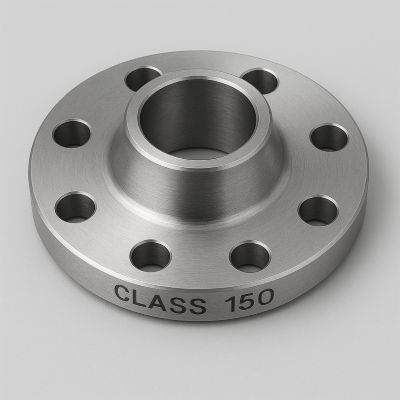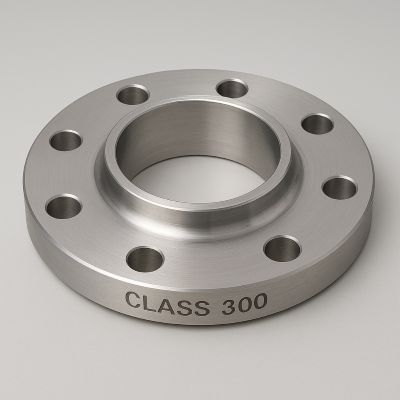When building or maintaining a piping system, choosing the right flange class is critical to ensuring both safety and efficiency. Flanges serve as essential connectors between pipes, valves, pumps, and other equipment, allowing for easy assembly, disassembly, and maintenance.
In the world of piping, not all flanges are created equal. They’re categorized by pressure classes that indicate how much pressure and temperature they can safely handle. These are often referred to as ANSI/ASME pressure classes, with the most common being Class 150, 300, 600, 900, 1500, and 2500.
Many engineers and buyers often find themselves comparing Class 150 vs Class 300 flanges, wondering which one suits their application best. Let’s break down their differences, use cases, and what you should consider before making your choice.
What Are Flange Pressure Classes?
A flange pressure class (or rating) defines the maximum pressure a flange can withstand at a specific temperature. This classification ensures compatibility and safety in high-pressure systems.
The ASME B16.5 standard sets these pressure ratings for flanges made from different materials, such as carbon steel, stainless steel, or alloy steel. The ratings, like 150, 300, 600, etc., don’t directly represent the pressure in psi; rather, they are nominal class numbers that correspond to a pressure–temperature chart.
Simply put:
➡️ The higher the class number, the greater the pressure and temperature tolerance.
➡️ The material of the flange also affects the pressure rating; for example, stainless steel flanges can handle slightly different limits than carbon steel ones.
Overview of Class 150 Flange
A. Pressure & Temperature Ratings
Class 150 flanges are commonly used for low-pressure and moderate-temperature applications.
➡️ At around 100°F, a carbon steel Class 150 flange can handle up to approximately 285 psi.
➡️ However, as the temperature increases, the allowable pressure decreases—meaning it’s best suited for stable, low-stress conditions.
B. Common Applications
You’ll typically find Class 150 flanges in:
➡️ Water and air lines
➡️ HVAC systems
➡️ Oil and gas transfer at low pressure
➡️ Light industrial and irrigation systems
C. Advantages
➡️ Affordable: Lower cost makes them ideal for budget-conscious projects.
➡️ Easy to install and replace: Lightweight and standardized dimensions make them simple to handle.
➡️ Widely available: Most suppliers stock Class 150 flanges in various materials and sizes.
Overview of Class 300 Flange
A. Pressure & Temperature Ratings
Class 300 flanges are built for higher pressure and temperature applications.
➡️ At 100°F, a carbon steel Class 300 flange can handle around 740 psi—more than twice that of a Class 150 flange.
➡️ This makes them reliable in systems that experience higher stress or temperature fluctuations.
B. Common Applications
➡️ High-pressure pipelines and process plants
➡️ Steam and chemical systems
➡️ Oil refineries and gas transmission
➡️ Power generation facilities
C. Advantages
➡️ Greater strength and durability: Ideal for heavy-duty and high-risk environments.
➡️ Enhanced safety margins: Suitable for critical systems where even minor leaks can cause significant issues.
➡️ Longer lifespan: Designed to handle more demanding operating conditions.
Key Differences Between 150 and 300 Flanges
|
Feature |
Class 150 Flange |
Class 300 Flange |
|
Pressure Rating |
Up to ~285 psi @100°F |
Up to ~740 psi @100°F |
|
Thickness |
Thinner |
Thicker, heavier |
|
Bolt Circle Diameter |
Smaller |
Larger |
|
Number & Size of Bolts |
Fewer/smaller |
More/larger |
|
Weight |
Lighter |
Heavier |
|
Cost |
Lower |
Higher |
|
Applications |
Low-pressure systems |
High-pressure systems |
Tip: Visual aids such as a comparison chart or infographic can make it easier to grasp these mechanical differences at a glance.
Factors to Consider When Choosing
When deciding between Class 150 and 300 flanges, consider the following:
1. System Pressure & Temperature: Match the flange class to your operating conditions. High pressure and temperature systems demand a Class 300 flange.
2. Material Compatibility: Pressure ratings change based on the material. Always confirm the flange’s compatibility with your pipeline material.
3. Pipeline Design & Safety Codes: Some projects require a higher class to meet safety or regulatory standards.
4. Cost vs. Performance: Class 150 is more economical, but Class 300 offers higher reliability and longer service life.
5. Future Scalability: If system upgrades or increased capacity are planned, Class 300 may be the more future-proof choice.
Can You Mix 150 and 300 Flanges?
Mixing flange classes, such as connecting a Class 150 flange with a Class 300 flange, is not recommended.
Here’s why:
➡️ The bolt patterns and dimensions differ, preventing a proper seal.
➡️ Even if forced to fit, mismatched pressure ratings can cause leaks, misalignment, or catastrophic failure.
➡️ Always ensure both flanges share the same pressure class, size, and facing type (e.g., raised face or flat face).
In short, pairing different flange classes compromises both safety and system integrity.
Practical Scenarios
Here’s how to decide which flange class fits your application:
Example 1: Low-pressure water system → Class 150 flange is sufficient.
Example 2: High-pressure steam line or chemical pipeline → Class 300 flange recommended.
Example 3: Oil & gas pipelines requiring additional safety margin → Class 300 or higher.
By aligning the flange class with your system’s demands, you reduce maintenance costs and prevent operational issues.
Conclusion
Choosing between a 150 flange and a 300 flange comes down to your system’s pressure, temperature, and safety requirements.
➡️ Class 150 flanges are cost-effective and perfect for low-pressure, low-risk applications.
➡️ Class 300 flanges, on the other hand, offer higher strength, durability, and safety for demanding systems.
When in doubt, always consult with your engineer or flange supplier to ensure compliance with design standards and operating conditions.
Need help selecting the right flange for your project?
Contact our technical team today for expert guidance and reliable flange solutions tailored to your application.
Post time: Oct-17-2025



